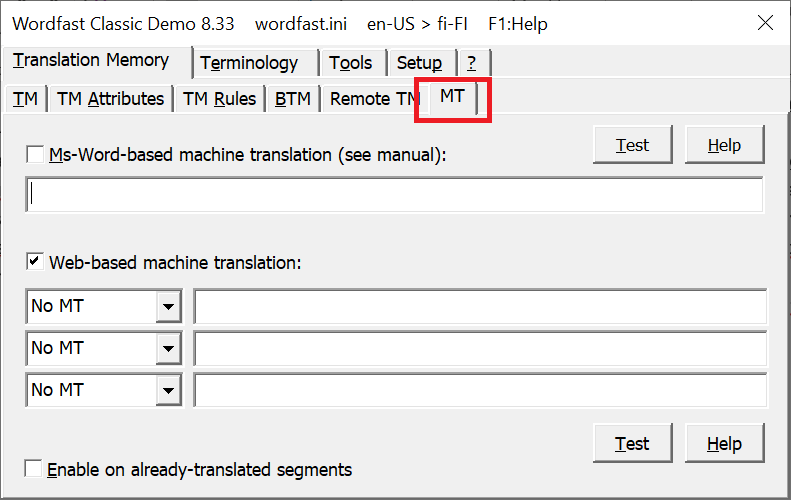

- #Wordfast classic how to create and use a tm pdf
- #Wordfast classic how to create and use a tm update
- #Wordfast classic how to create and use a tm trial
Clean-up the RTF/DOC file in Trados Workbench (work on a copy of the file - I recommend creating a brand new TM for every particular ITD/TTX) with Update TM radio button activated.ĩ. Work in WF as usual (when reviewing, ShowBetterMatch is more advisable then WriteBetterMatch)Ĩ. However, you need all the red text in "tw4wininternal" style. Note: You might consider deleting all the text that is in gray "tw4winexternal" style (with FR, Ctrl-H) since you don?t need it really. Save the file in Word as RTF or DOC (DOC is sometimes better for CE and Cyrillic languages). In Tag Editor?s Edit window press Ctrl-A (Select All), then copy the text (Ctrl-C), then Alt-Tab to Word, and paste the text (Ctrl-V).Ħ. Trados will open TWB and might complain there is no TM open, so create a new, empty one.ĥ. Open the exported TTX in Trados Tag Editor (at this point, Trados Workbench is not needed). Fully functional WF (for translations of more than 500 TUs)Ĥ.
#Wordfast classic how to create and use a tm trial
Fully functional SDLX (the trial version is useful only for exporting TTXs - the demo version, after the trial period, doesn?t allow for saving ITDs) 5.5) (the demo version is useful only for cleaning up translated and segmented WF files) Or if you disregard ITD files, just a procedure for translating TTX files in WF and getting them back into Tag Editor. Do you have any ideas on what to do? I am using version 2011.CAT juggling procedure for ITD files from SDLX via (Trados Workbench and Tag Editor) TTX for working in Wordfast and back to ITD through TTX. I am really lost as to why I can´t move beyond this step to import my glossary. I am so frustrated, I am about to take my file home to translate in Wordfast on my home computer. When I go to the toolbar above and try that way, all of the options are gray and I can´t click them. The termbase IS there and when I go to Catalog, it shows me all the information about it, BUT, I get NO information on the left-hand side with the option to import. I have followed the instructions to several tutorials to no avail. I have deleted all files and started from scratch numerous times. I started from scratch and am converting the excel glossaries in Converter (which is working find and showing me the number of entries it is converting), but when I get to Multiterm, I can´t import into the termbase I created for the glossary. I was able to create and upload one termbase following the instructions, but the next ones I tried each produced a termbase with just ONE entry. Your tutorial was very helpful! Thank you for the effort. Obviously this only works for new termbases and not for importing a newly converted xml file into an existing termbase. This then ensures the subsequent import of terms runs smoothly in nearly all cases. When creating your termbase ready for the import, select the "Load an existing termbase definition file" and browse for the xdt file. Once this is completed, a termbase definition file is automatically created and saved in xdt format. The first thing to do is convert the excel file as you explain. When working with a glossary in excel with a structure that contains descriptive fields in addition to the Index fields, I find it useful to create a whole new termbase from scratch. I would like to add one tip I have found useful for avoiding the 0-entries-imported problem mentioned by Judith above, if I may. I found the section on the Index field and Descriptive field to be especially useful - I've fallen down at this stage many times in the past. Hi Jayne - thanks for the very handy manual. How to import a bilingual Excel glossary into MultiTerm I’ve explained the steps in MultiTerm2011 – and if you have the 2009 or 2014 version, the steps are almost identical, so you’ll still be able to follow them.

#Wordfast classic how to create and use a tm pdf
You can then follow the steps in the PDF below to convert and import a bilingual glossary from Excel. Then you can use term recognition within Studio to speed up your translations and improve your translation quality and consistency.īefore you begin, you’ll need to create a termbase in MultiTerm – there are instructions on how to do this here. The process might seem complicated and it takes a bit of time to set up your termbase initially – but once you’ve done it, it’s very easy to use the termbase in multiple projects. (You might also want to look at: The quick way to convert glossaries and termbases between Excel and MultiTerm.) The PDF below shows how to use MultiTerm to do this. If you use Trados Studio, it’s a good idea to learn how to use MultiTerm to manage your terminology.įor example, you might want to use terms from a bilingual Excel glossary when you’re translating in Trados Studio.


 0 kommentar(er)
0 kommentar(er)
